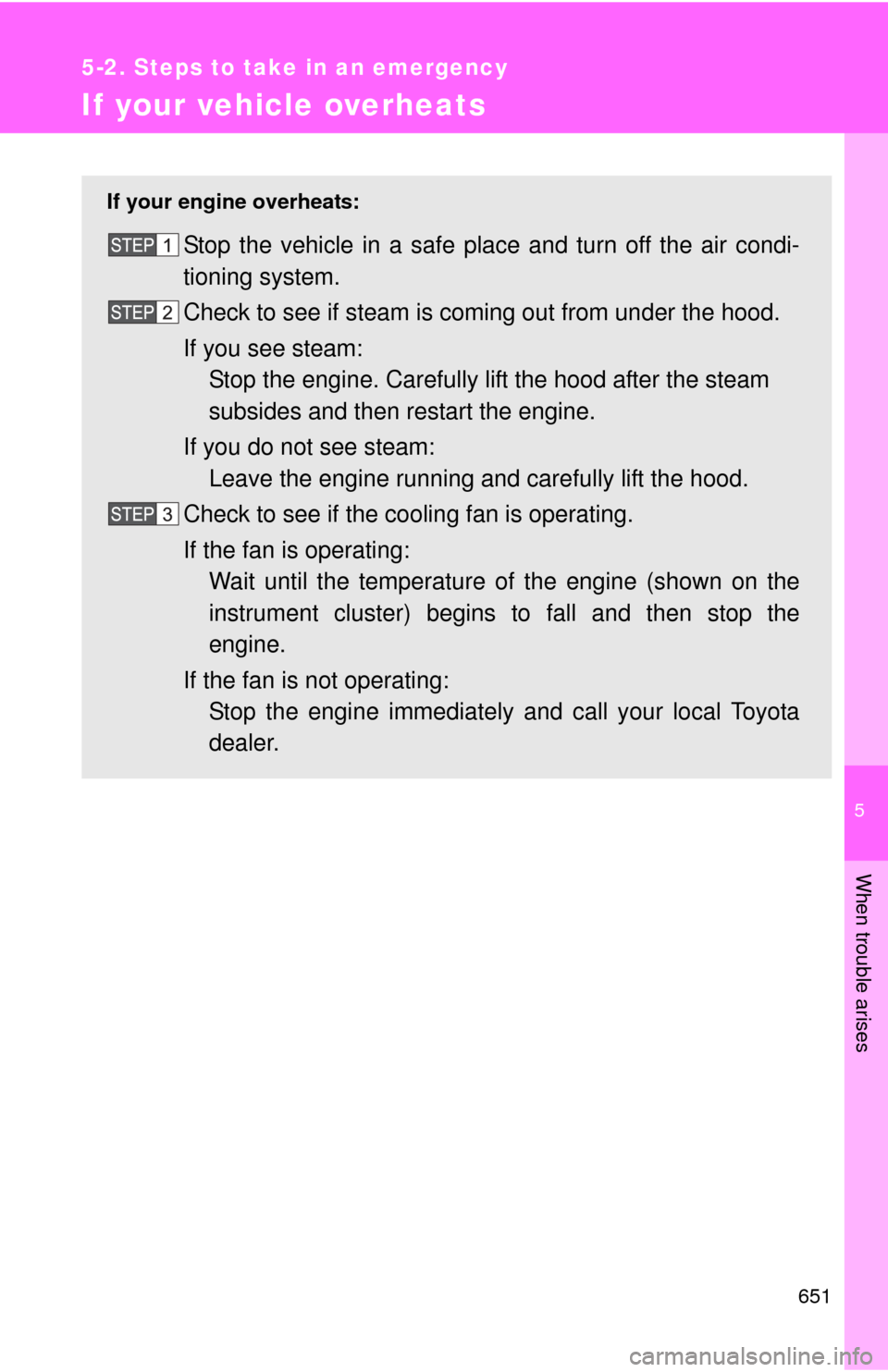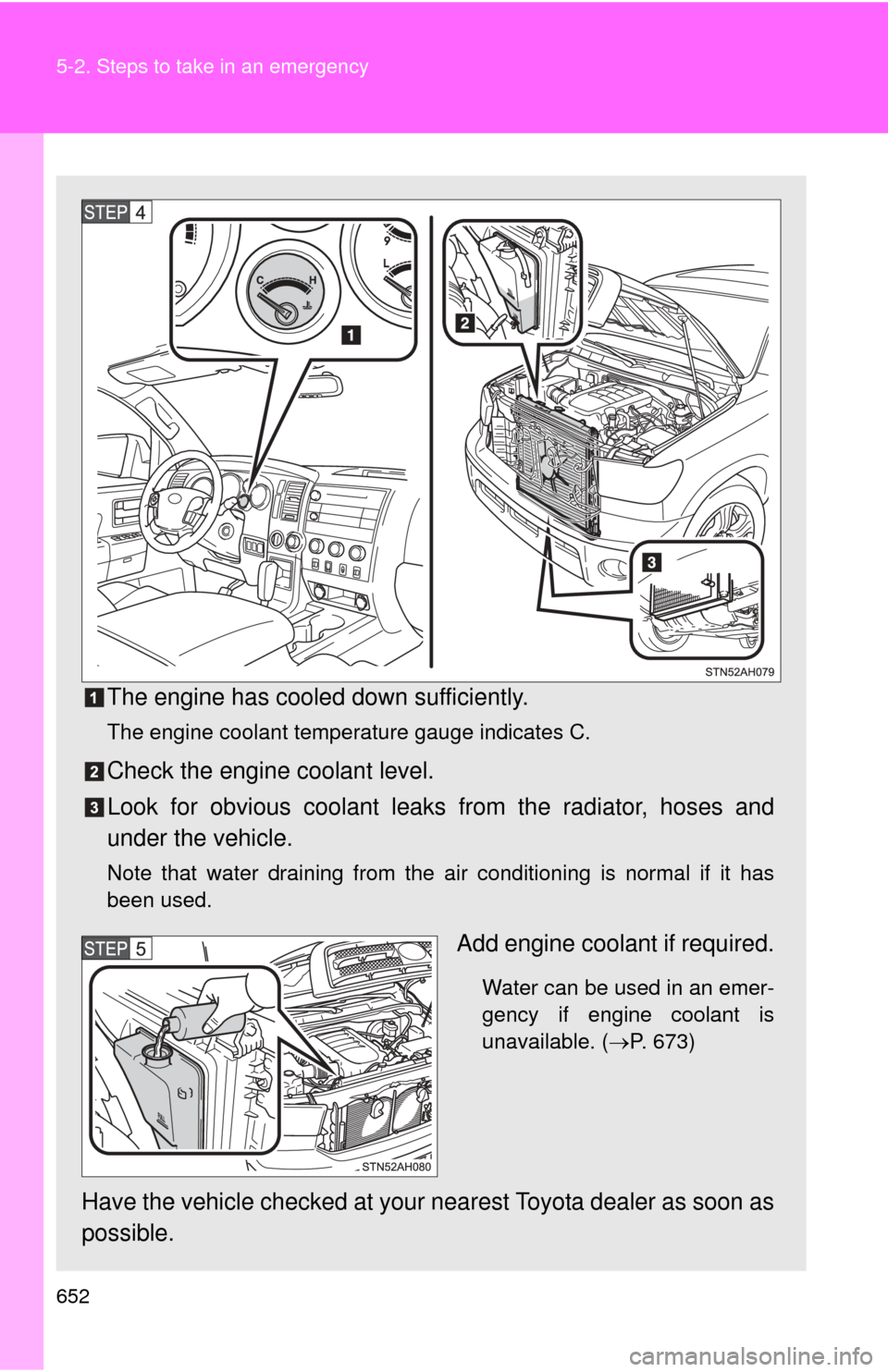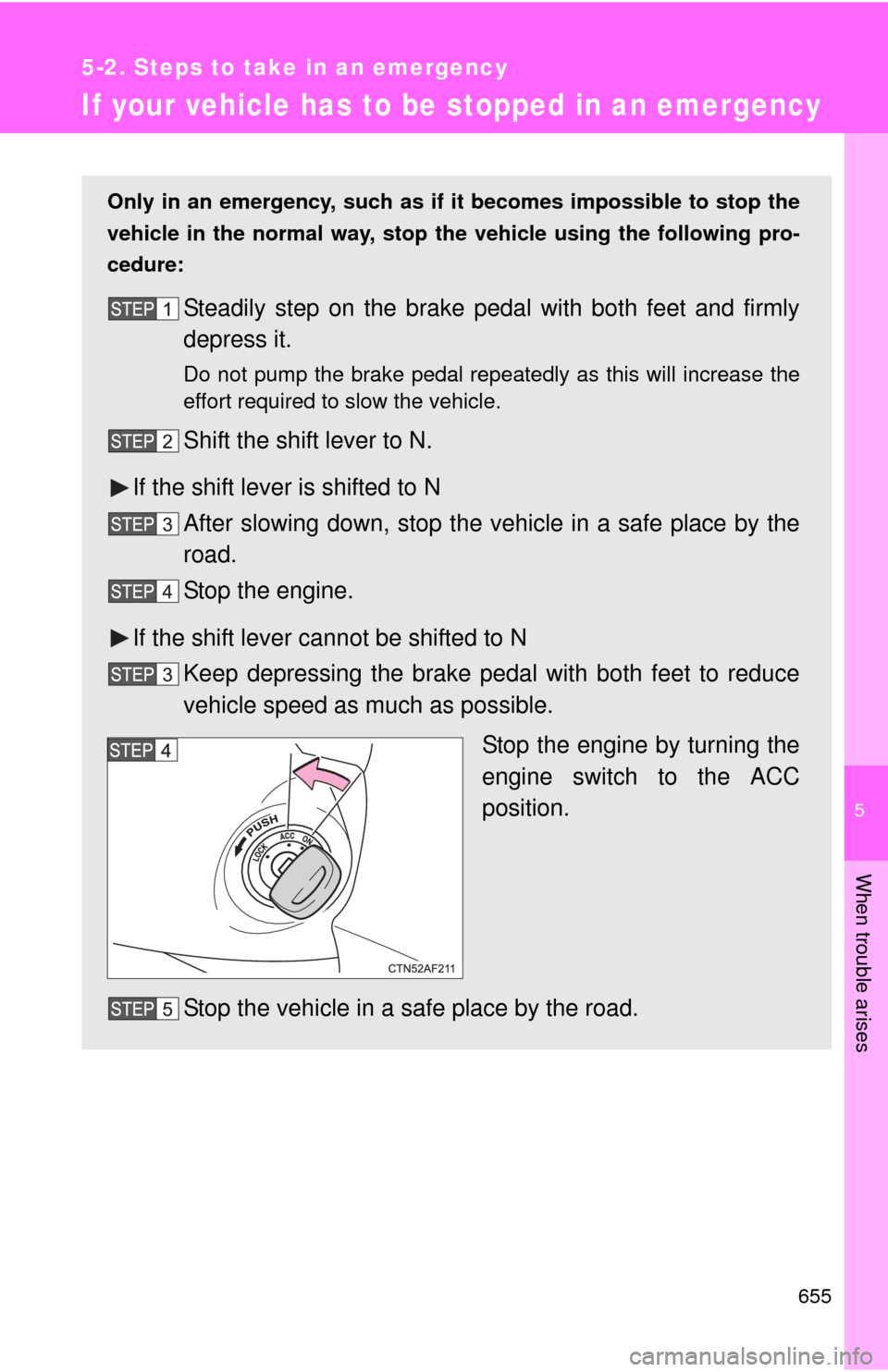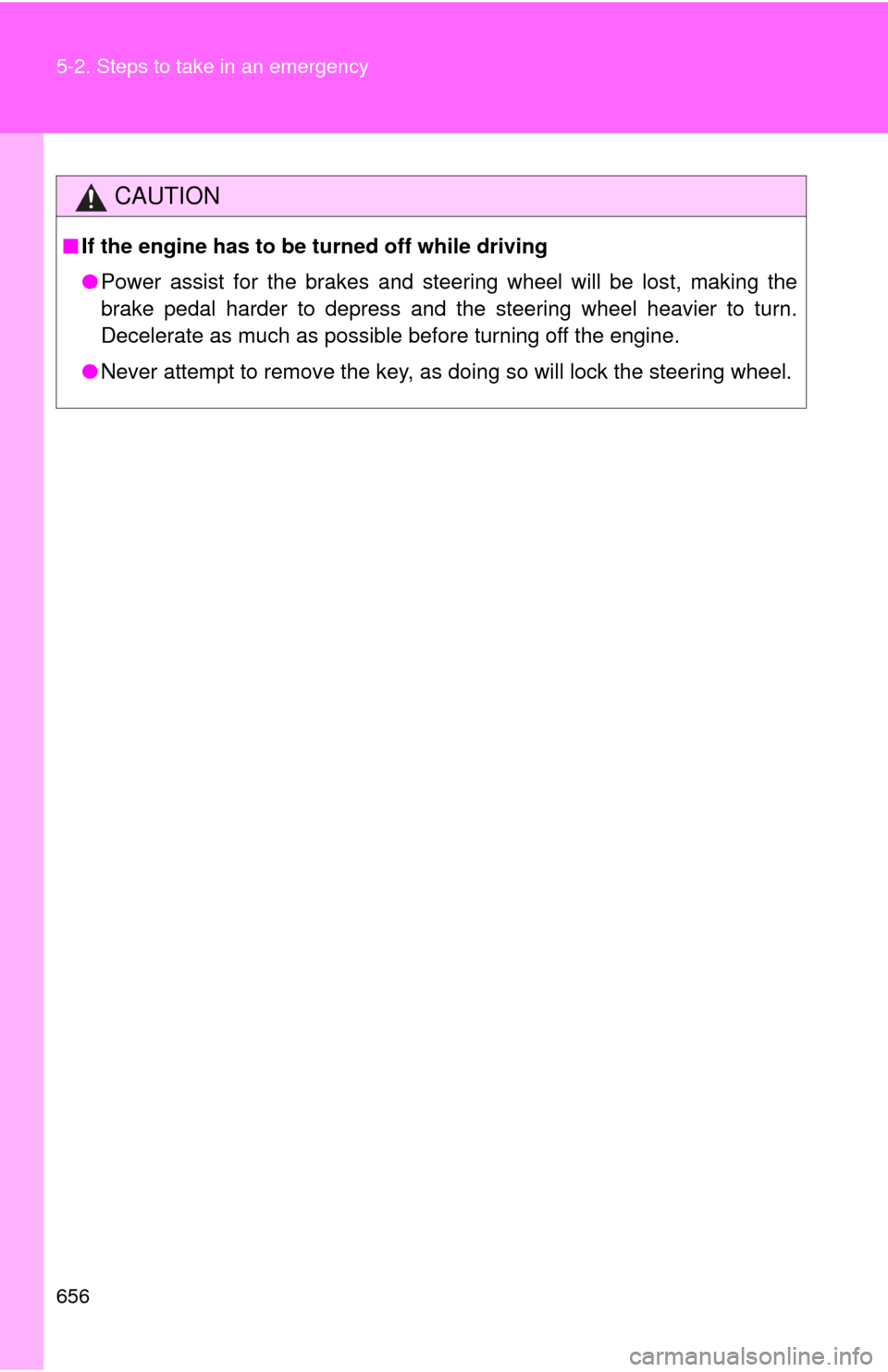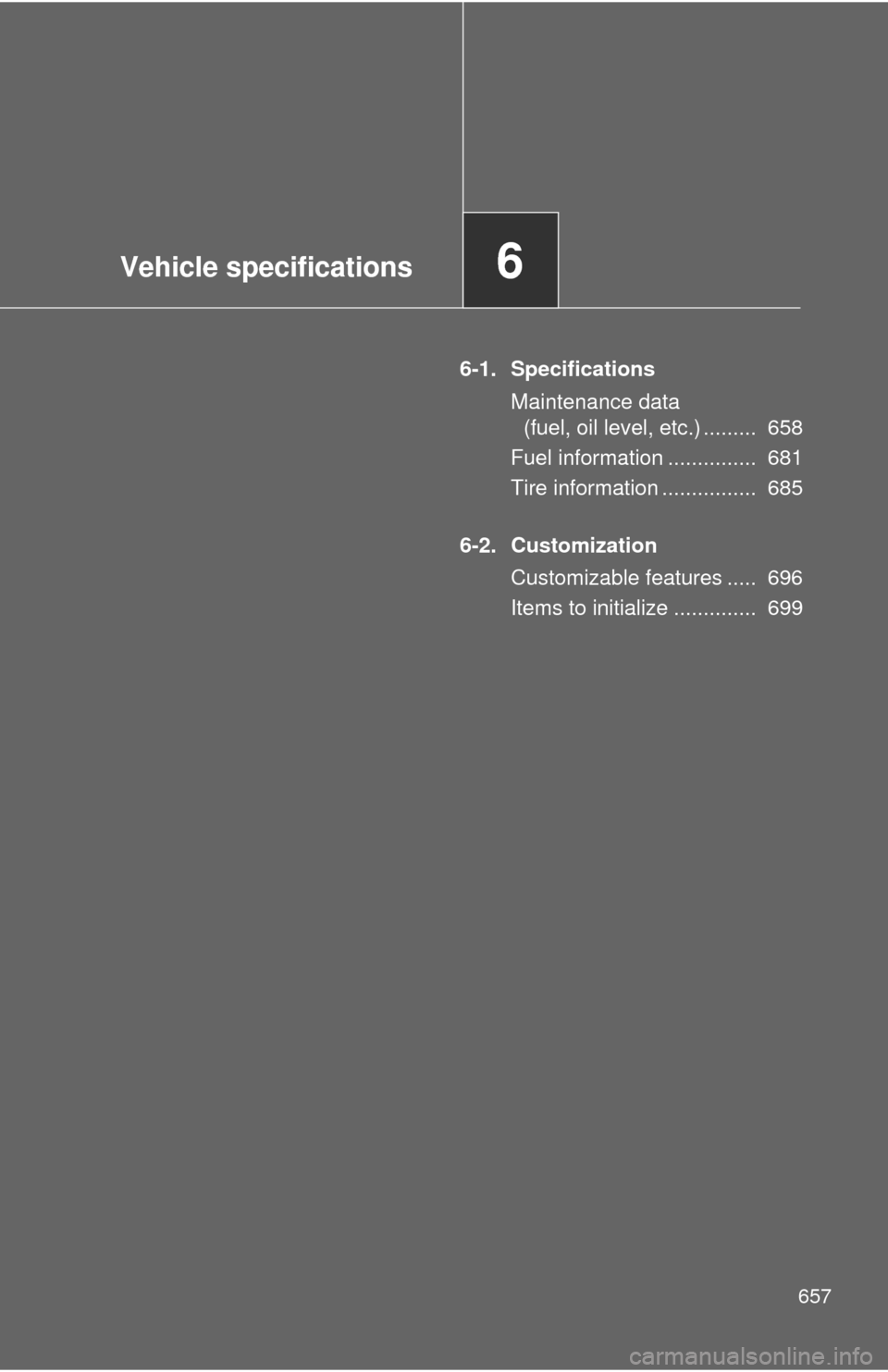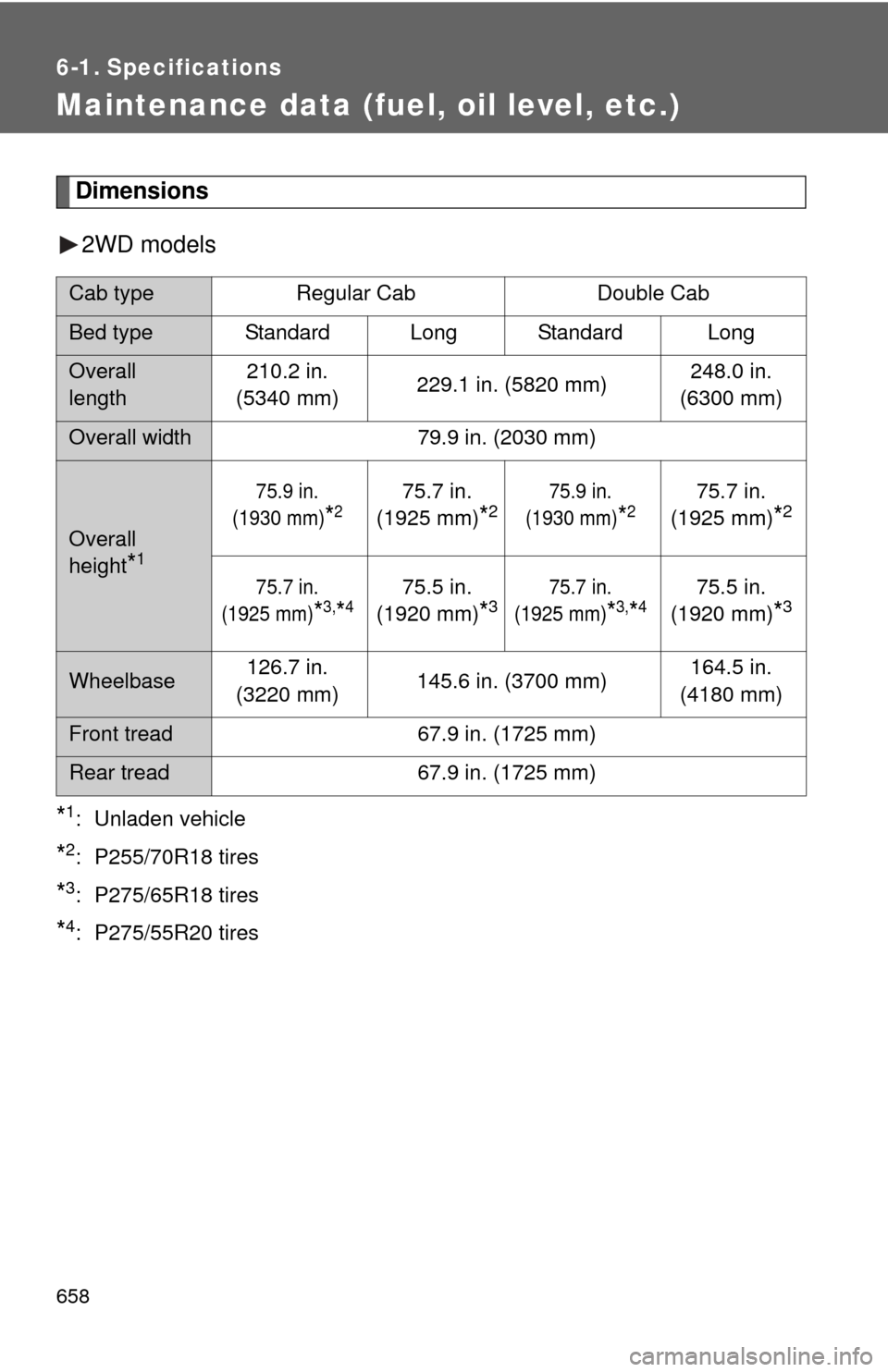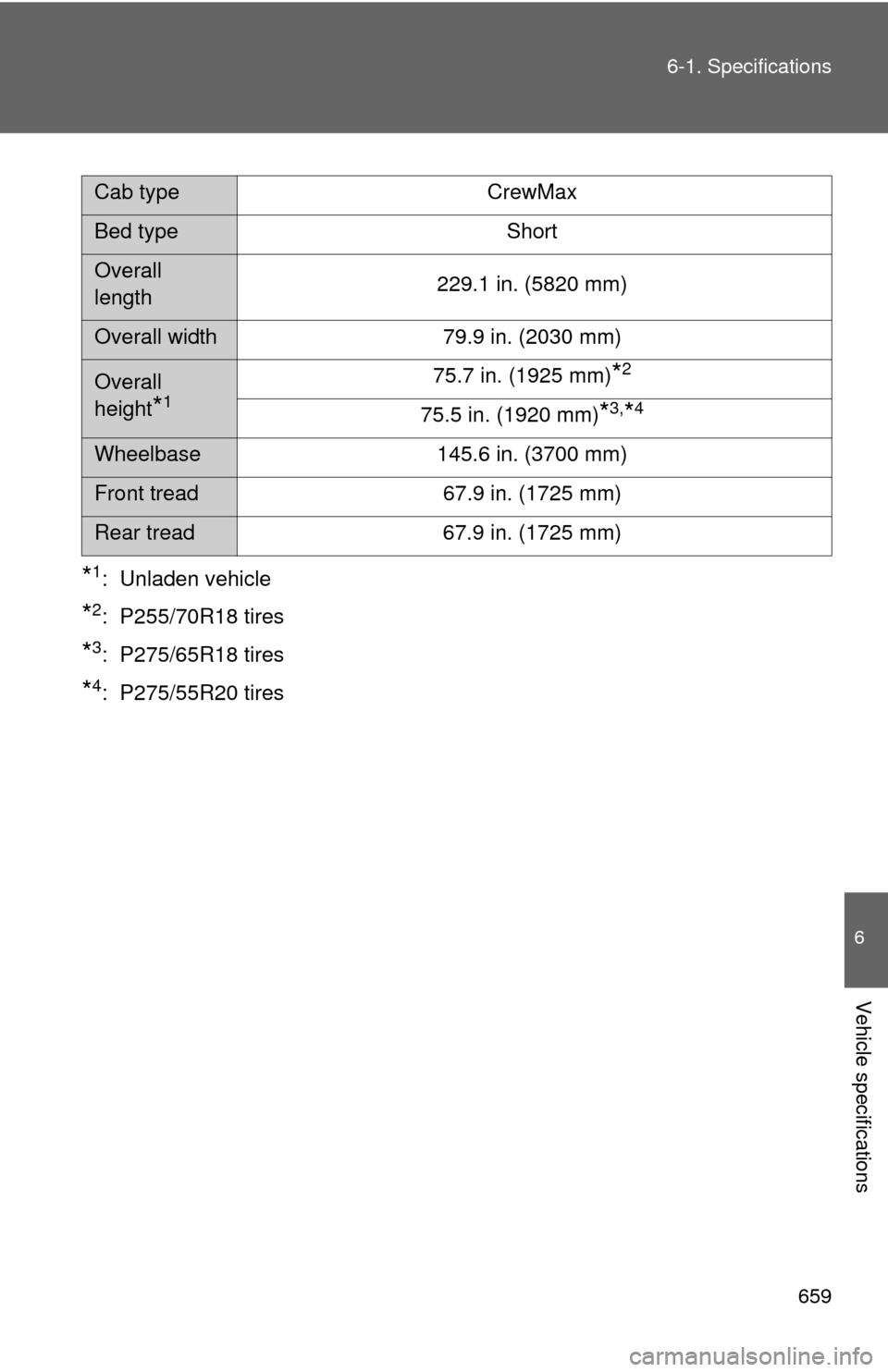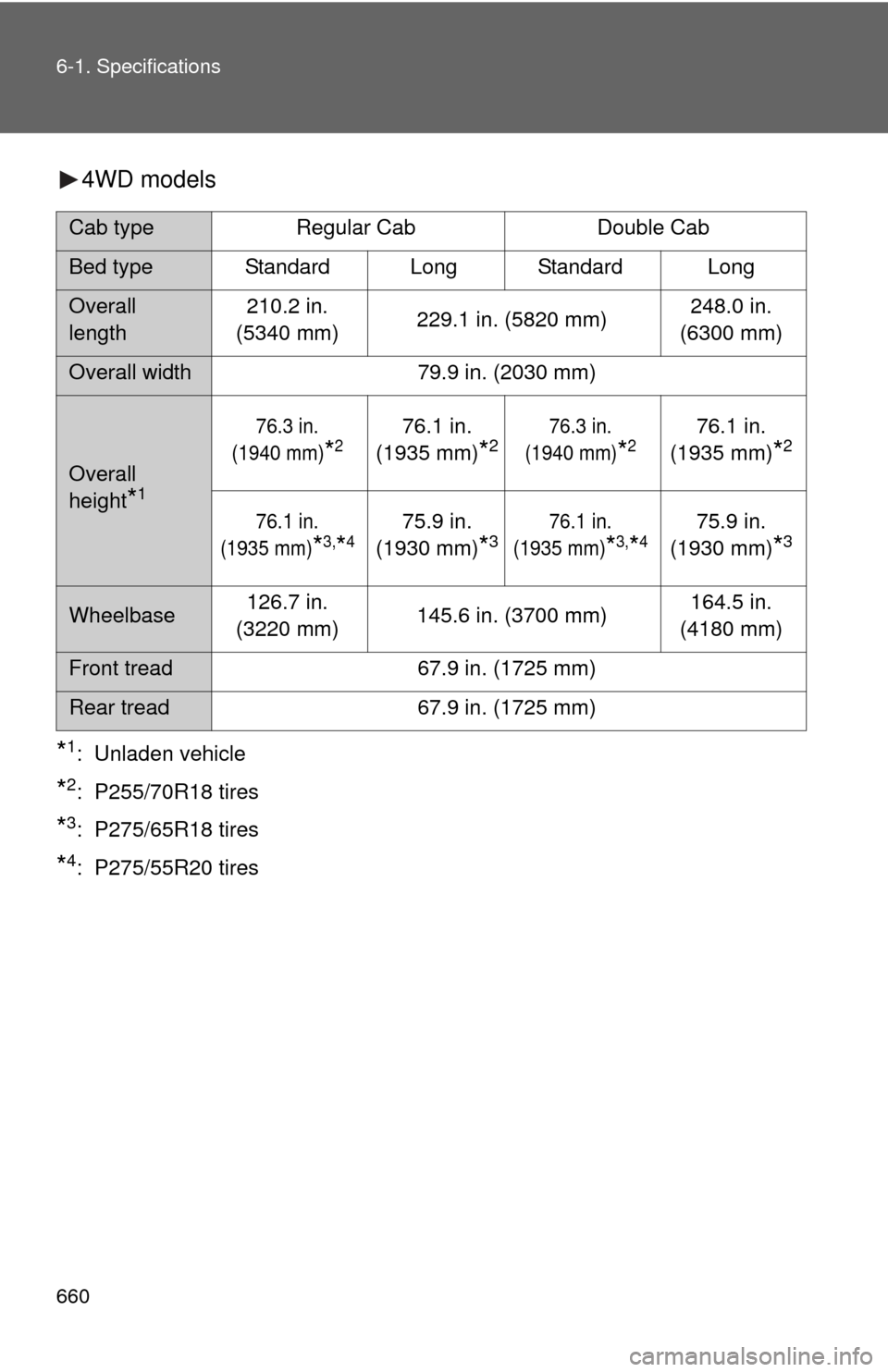TOYOTA TUNDRA 2012 2.G Owners Manual
TUNDRA 2012 2.G
TOYOTA
TOYOTA
https://www.carmanualsonline.info/img/14/6834/w960_6834-0.png
TOYOTA TUNDRA 2012 2.G Owners Manual
Trending: clock reset, battery capacity, instrument cluster, driver seat adjustment, windshield wipers, height adjustment, wheel bolts
Page 651 of 744
5
When trouble arises
651
5-2. Steps to take in an emergency
If your vehicle overheats
If your engine overheats:
Stop the vehicle in a safe place and turn off the air condi-
tioning system.
Check to see if steam is coming out from under the hood.
If you see steam: Stop the engine. Carefully lift the hood after the steam
subsides and then restart the engine.
If you do not see steam: Leave the engine running and carefully lift the hood.
Check to see if the cooling fan is operating.
If the fan is operating: Wait until the temperature of the engine (shown on the
instrument cluster) begins to fall and then stop the
engine.
If the fan is not operating: Stop the engine immediately and call your local Toyota
dealer.
Page 652 of 744
652 5-2. Steps to take in an emergency
The engine has cooled down sufficiently.
The engine coolant temperature gauge indicates C.
Check the engine coolant level.
Look for obvious coolant leaks from the radiator, hoses and
under the vehicle.
Note that water draining from the air conditioning is normal if it has
been used.
Add engine coolant if required.
Water can be used in an emer-
gency if engine coolant is
unavailable. ( P. 673)
Have the vehicle checked at your nearest Toyota dealer as soon as
possible.
Page 653 of 744
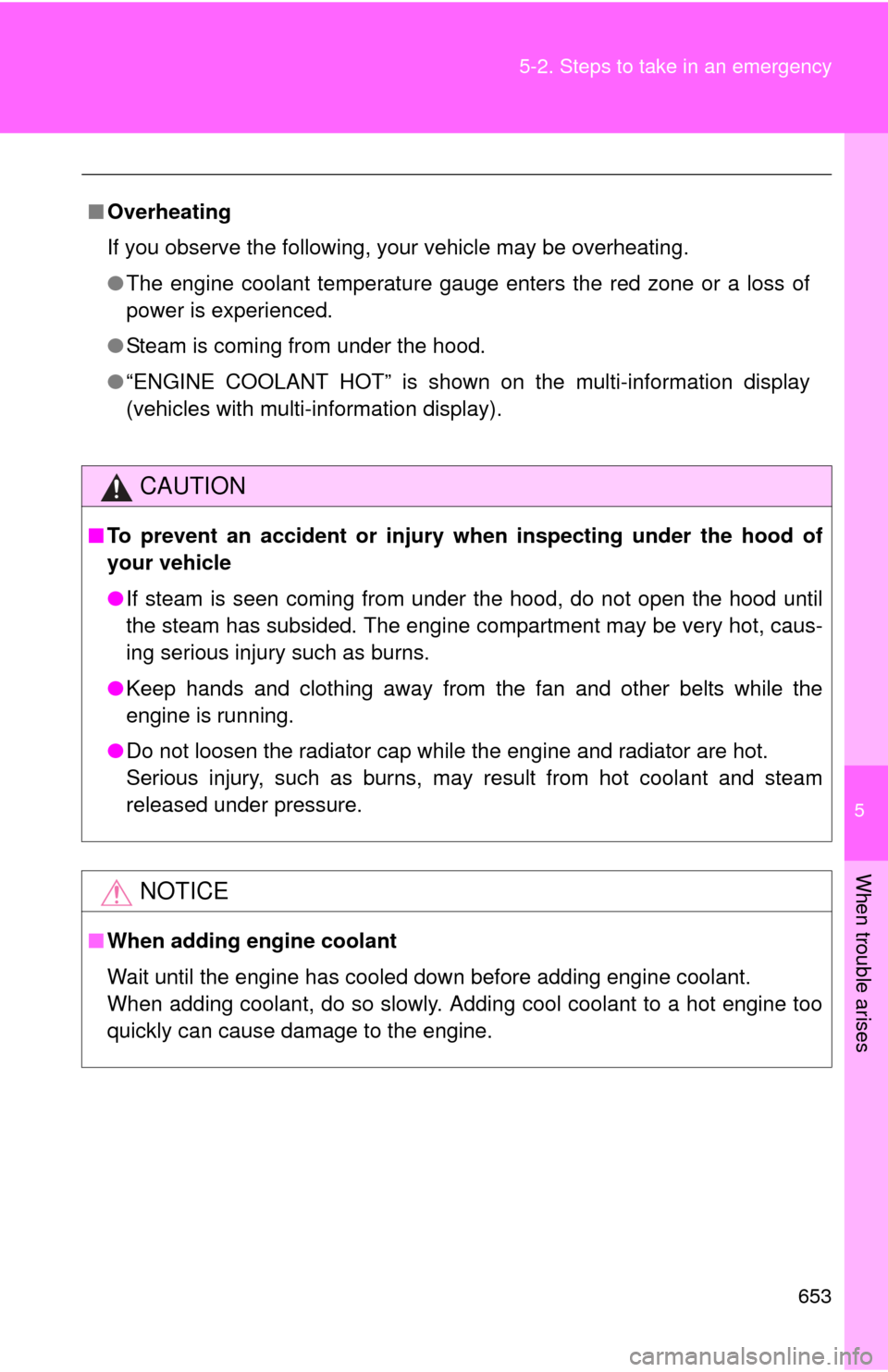
5
When trouble arises
653
5-2. Steps to take in an emergency
■
Overheating
If you observe the following, your vehicle may be overheating.
●The engine coolant temperature gauge enters the red zone or a loss of
power is experienced.
● Steam is coming from under the hood.
● “ENGINE COOLANT HOT” is shown on the multi-information display
(vehicles with multi-information display).
CAUTION
■To prevent an accident or injury when inspecting under the hood of
your vehicle
●If steam is seen coming from under the hood, do not open the hood until
the steam has subsided. The engine compartment may be very hot, caus-
ing serious injury such as burns.
● Keep hands and clothing away from the fan and other belts while the
engine is running.
● Do not loosen the radiator cap while the engine and radiator are hot.
Serious injury, such as burns, may result from hot coolant and steam
released under pressure.
NOTICE
■When adding engine coolant
Wait until the engine has cooled down before adding engine coolant.
When adding coolant, do so slowly. Adding cool coolant to a hot engine too
quickly can cause damage to the engine.
Page 654 of 744
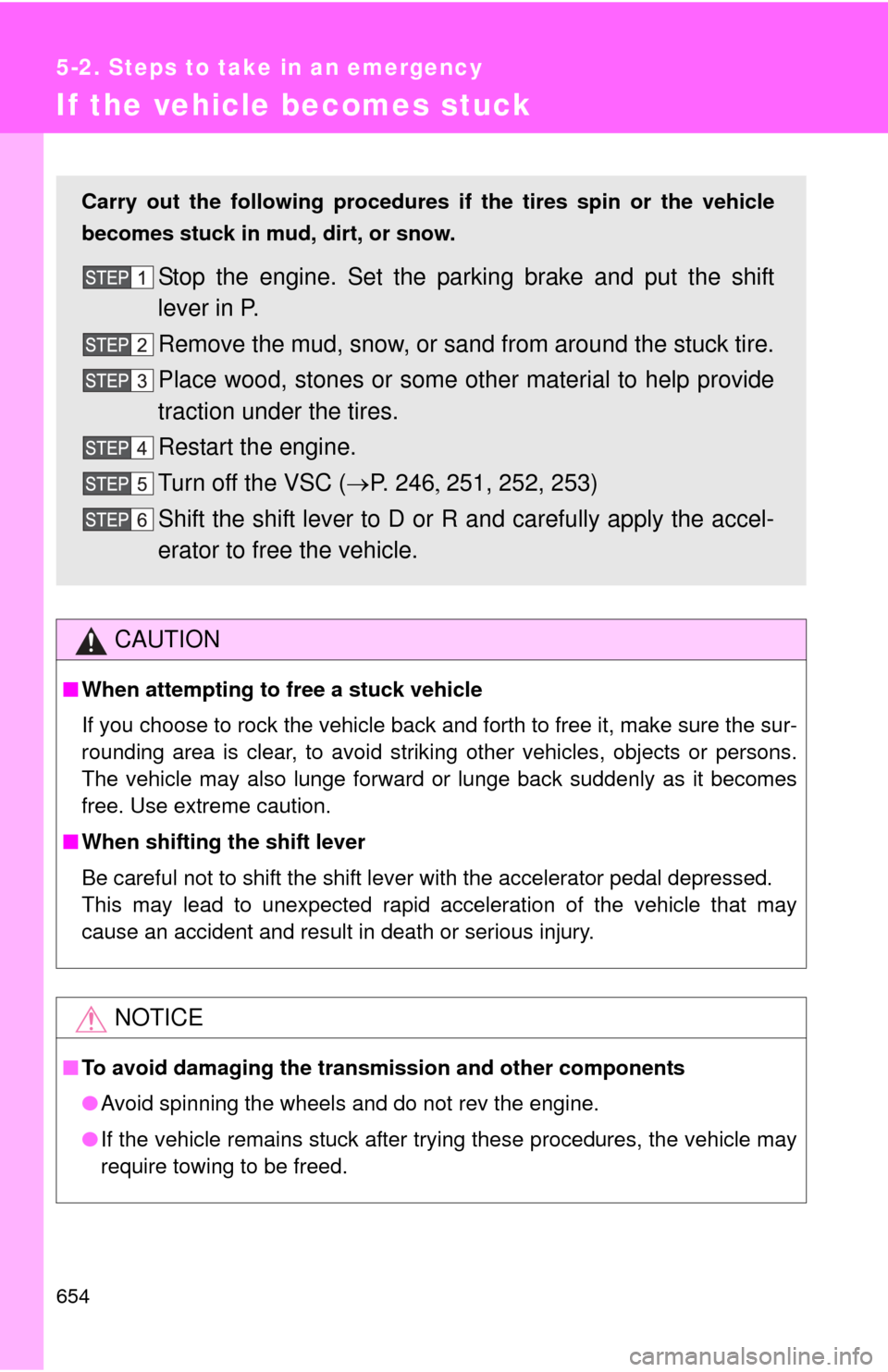
654
5-2. Steps to take in an emergency
If the vehicle becomes stuck
CAUTION
■When attempting to free a stuck vehicle
If you choose to rock the vehicle back and forth to free it, make sure the sur-
rounding area is clear, to avoid striki ng other vehicles, objects or persons.
The vehicle may also lunge forward or lunge back suddenly as it becomes
free. Use extreme caution.
■ When shifting the shift lever
Be careful not to shift the shift lever with the accelerator pedal depressed.
This may lead to unexpected rapid acceleration of the vehicle that may
cause an accident and result in death or serious injury.
NOTICE
■To avoid damaging the transmission and other components
●Avoid spinning the wheels and do not rev the engine.
● If the vehicle remains stuck after trying these procedures, the vehicle may
require towing to be freed.
Carry out the following procedures if the tires spin or the vehicle
becomes stuck in mud, dirt, or snow.
Stop the engine. Set the parking brake and put the shift
lever in P.
Remove the mud, snow, or sand from around the stuck tire.
Place wood, stones or some other material to help provide
traction under the tires.
Restart the engine.
Turn off the VSC ( P. 2 4 6 251, 252, 253)
Shift the shift lever to D or R and carefully apply the accel-
erator to free the vehicle.
Page 655 of 744
5
When trouble arises
655
5-2. Steps to take in an emergency
If your vehicle has to be stopped in an emergency
Only in an emergency, such as if it becomes impossible to stop the
vehicle in the normal way, stop the vehicle using the following pro-
cedure:
Steadily step on the brake pedal with both feet and firmly
depress it.
Do not pump the brake pedal repeatedly as this will increase the
effort required to slow the vehicle.
Shift the shift lever to N.
If the shift lever is shifted to N After slowing down, stop the vehi cle in a safe place by the
road.
Stop the engine.
If the shift lever cannot be shifted to N Keep depressing the brake pedal with both feet to reduce
vehicle speed as much as possible.
Stop the engine by turning the
engine switch to the ACC
position.
Stop the vehicle in a safe place by the road.
Page 656 of 744
656 5-2. Steps to take in an emergency
CAUTION
■If the engine has to be turned off while driving
●Power assist for the brakes and steering wheel will be lost, making the
brake pedal harder to depress and the steering wheel heavier to turn.
Decelerate as much as possible before turning off the engine.
● Never attempt to remove the key, as doing so will lock the steering wheel.
Page 657 of 744
Vehicle specifications6
657
6-1. SpecificationsMaintenance data (fuel, oil level, etc.) ......... 658
Fuel information ............... 681
Tire information ................ 685
6-2. Customization Customizable features ..... 696
Items to initialize .............. 699
Page 658 of 744
658
6-1. Specifications
Maintenance data (fuel, oil level, etc.)
Dimensions2WD models
*1: Unladen vehicle
*2: P255/70R18 tires
*3: P275/65R18 tires
*4: P275/55R20 tires
Cab type Regular Cab Double Cab
Bed type Standard Long Standard Long
Overall
length210.2 in.
(5340 mm) 229.1 in. (5820 mm) 248.0 in.
(6300 mm)
Overall width 79.9 in. (2030 mm)
Overall
height
*1
75.9 in.
(1930 mm)
*275.7 in.
(1925 mm)
*275.9 in.
(1930 mm)
*275.7 in.
(1925 mm)
*2
75.7 in.
(1925 mm)
*3,*475.5 in.
(1920 mm)
*375.7 in.
(1925 mm)
*3,*475.5 in.
(1920 mm)
*3
Wheelbase 126.7 in.
(3220 mm) 145.6 in. (3700 mm) 164.5 in.
(4180 mm)
Front tread 67.9 in. (1725 mm)
Rear tread67.9 in. (1725 mm)
Page 659 of 744
659
6-1. Specifications
6
Vehicle specifications
*1: Unladen vehicle
*2: P255/70R18 tires
*3: P275/65R18 tires
*4: P275/55R20 tires
Cab type
CrewMax
Bed type Short
Overall
length229.1 in. (5820 mm)
Overall width
79.9 in. (2030 mm)
Overall
height
*1
75.7 in. (1925 mm)*2
75.5 in. (1920 mm)*3,*4
Wheelbase145.6 in. (3700 mm)
Front tread 67.9 in. (1725 mm)
Rear tread67.9 in. (1725 mm)
Page 660 of 744
660 6-1. Specifications
4WD models
*1: Unladen vehicle
*2: P255/70R18 tires
*3: P275/65R18 tires
*4: P275/55R20 tires
Cab typeRegular Cab Double Cab
Bed type Standard Long Standard Long
Overall
length210.2 in.
(5340 mm) 229.1 in. (5820 mm) 248.0 in.
(6300 mm)
Overall width 79.9 in. (2030 mm)
Overall
height
*1
76.3 in.
(1940 mm)
*276.1 in.
(1935 mm)
*276.3 in.
(1940 mm)
*276.1 in.
(1935 mm)
*2
76.1 in.
(1935 mm)
*3,*475.9 in.
(1930 mm)
*376.1 in.
(1935 mm)
*3,*475.9 in.
(1930 mm)
*3
Wheelbase 126.7 in.
(3220 mm) 145.6 in. (3700 mm) 164.5 in.
(4180 mm)
Front tread 67.9 in. (1725 mm)
Rear tread67.9 in. (1725 mm)
Trending: wipers, deactivate airbag, service, remote start, instrument cluster, wheel size, coolant reservoir
